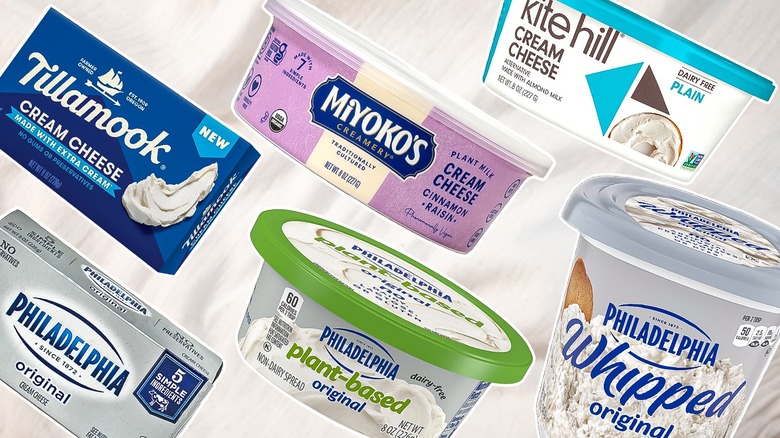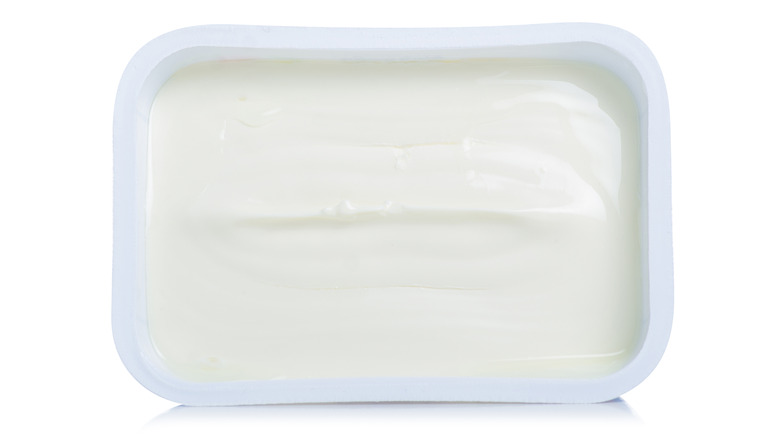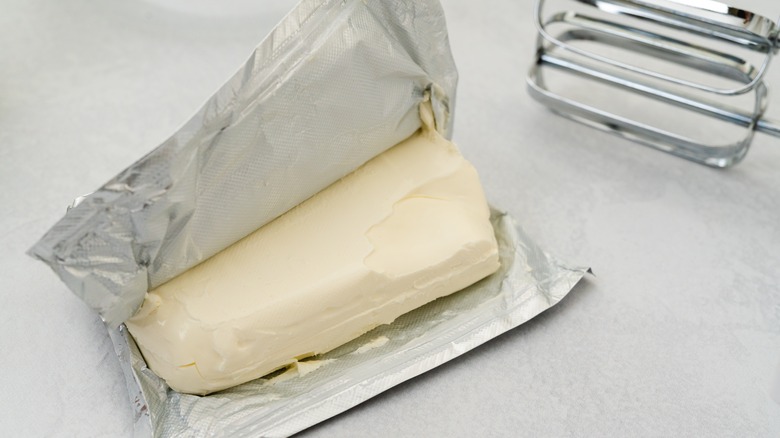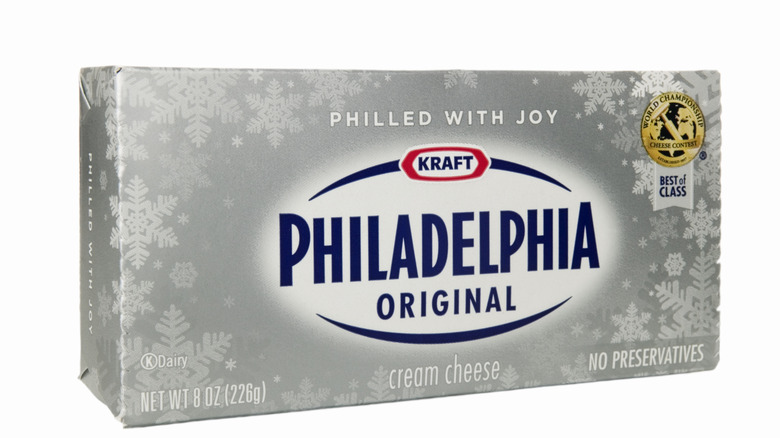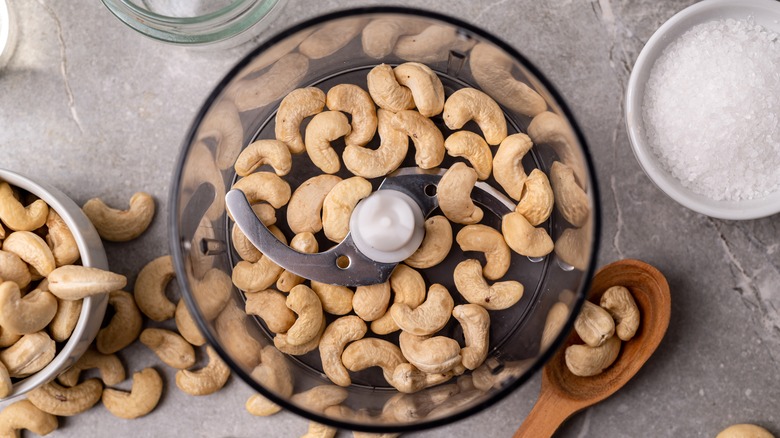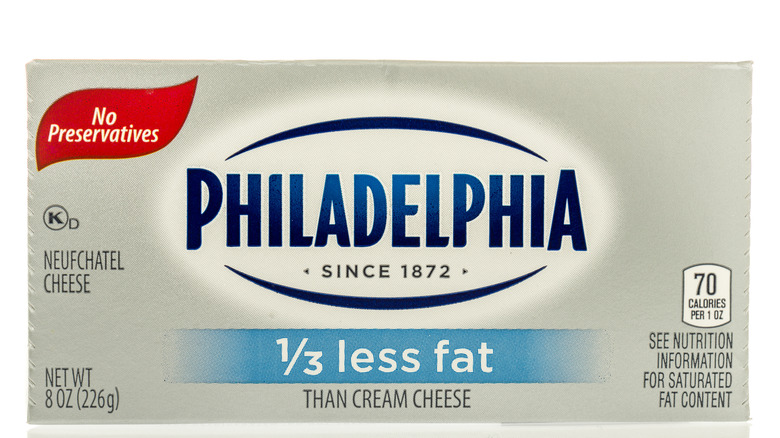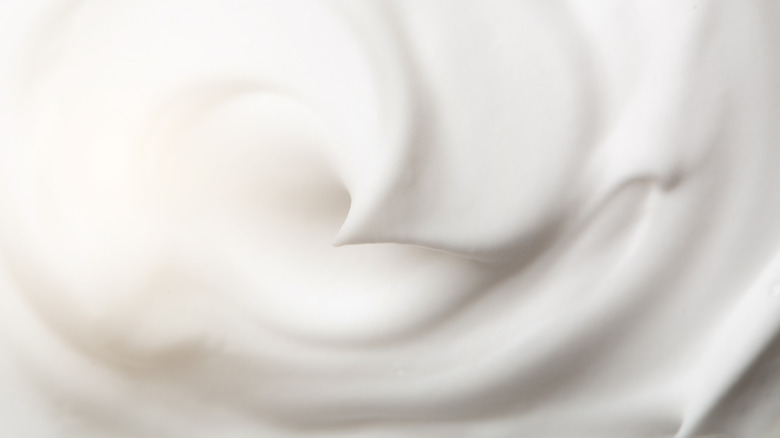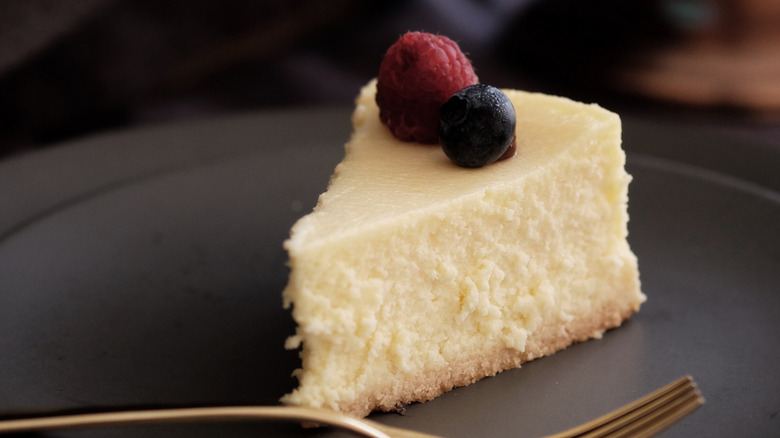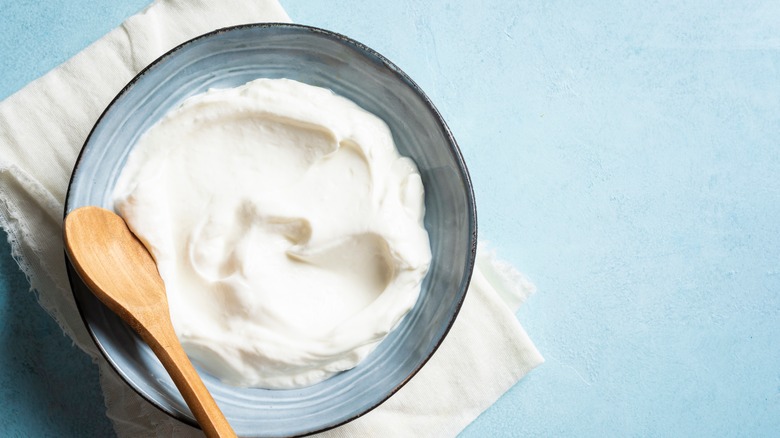9 Types Of Cream Cheese, Explained
Rumors abound that cream cheese was invented by accident, when one William Lawrence, a dairyman from New York, attempted to make Neufchatel, a cheese originating from Normandy, France. He failed in his intent, but his product was richer and creamier, so it wasn't a total loss. Meanwhile, others believe that this was no accident, and that, in fact, a recipe for cream cheese had already appeared in a Philadelphia newspaper as far back as 1769. Whatever the case may be, it is undisputed that William Lawrence, who named his cream cheese "Philadelphia," played a pivotal role in the marketing and popularization of cream cheese as we know and love it today.
But not even old William Lawrence could have foreseen the many different directions cream cheese would take after that. Indeed, its creamy consistency and mild flavor make it a versatile ingredient in both savory and sweet dishes. Today, one can find this ubiquitous cheese product in many different flavors, including smoked salmon, blueberry, and cinnamon raising, while many different types have also proliferated, including plant-based cream cheese, whipped cream cheese, and a variety made specifically for cheesecake fillings. It is to these types of cream cheese that we turn to today in order to find out more about each one, where they came from, and how best to use them.
Soft
So, you have cream cheese on your shopping list and a handful of other items. You'd think this means you can swing by the grocery store and just grab the cream cheese off the shelf and quickly make your way to the cashiers. But, we encourage you to think again, because shopping for that cream cheese may take longer than you think. Maybe not as long as shopping for a prom dress, but close to it. That's because there are so many different kinds of cream cheese out there now, that you really have to pay attention to what you grab.
Gone are the days where you could just pick the first package you see. Now you have to determine whether you need soft cream cheese or something else. Soft cream cheese typically comes in a tub container instead of a cardboard box lined with foil. It is not as pure as the stuff in the cardboard box, because it's designed to be spreadable and is literally softer, and contains more air, even when it's in the fridge. This allows you to take it out and spread it over your bagel right away, without having to take a scalpel to the cream cheese as you might need to do with a pure, solid block. The tub container also assumes you'll only be taking a little bit at a time. When you're done, you can just put the lid back on instead of dealing with a messy tinfoil situation.
Brick
Brick cream cheese is the purest form of cream cheese and is most often used in baking. It assumes that you will be using the entire block of cream cheese at once instead of chipping away at it little by little, so there are no nifty packaging tricks to allow you to close it up easily and save it for later. The shape and the fact that you can easily pick it up and handle a block makes it is easier to measure it, and its texture also softens more quickly and easily for when you want to use it in frostings. This is because the brick version of cream cheese doesn't include the air and lactic acid that are often whipped into soft cream cheese to keep it soft.
Brick cream cheese also doesn't have the somewhat grainy texture soft cream cheese can adopt when it's baked into cheesecakes or other desserts. Cream cheese in a tub also tends to release more water in the mixing stage, so it could lead to a wetter, and therefore undesirable texture unless you alter the proportion of the rest of the ingredients or take pains to drain the soft cream cheese before using it. Use brick cream cheese in a wide range of baking applications, including a rich cream cheese frosting for this black forest cake or this silky creamed spinach.
Original
The original or plain cream cheese flavor is just cream cheese without any additional flavoring, but it can come as a brick, as soft cheese in a tub, or even as whipped or plant-based cream cheese. As such, this designation primarily applies to the taste. Indeed, this type provides the basis for all other cream cheese flavorings, which are many and varied and sometimes even weird. In the case of Philadelphia, for instance, the brick form contains nothing but pasteurized milk, cream, salt, carob bean gum, and cheese culture.
But Philadelphia has also widened its horizons to include all sorts of added flavors. Chive and onion, strawberry, blueberry, spicy jalapeño, garden vegetable, honey pecan, smoked salmon, and garlic and herb are just some of the most popular ones. Other cream cheese brands have followed suit or come up with their own unique flavors, including Kite Hill's everything flavor, inspired by the everything bagel and no doubt meant to be spread on it. There is also Miyoko's cinnamon raisin cream cheese, which is not only great on cinnamon raisin bagels, but it's also made with cashew milk, making it a great vegan option. Whichever flavor you go for, know that they all use some form of original cream cheese as their base, and so can you. Feel free to make your own flavor by mixing original cream cheese with whichever ingredients you like, whether they're sweet or savory.
Plant-based cream cheese
The modern age is a great time to be alive if you're vegan. There was a time, even just ten or twenty years ago, when the only foods you could eat as a vegan were rice and beans and a few well-meaning but ultimately unsuccessful attempts at making plant-based imitations of meat or dairy foods. Margarine, which is made with water and vegetable oils, comes to mind, along with its reputation for being highly processed and including high amounts of trans fats. But all that has changed. Grocery stores and restaurants now abound with vegan products that taste good in their own right, including cream cheeses made with cashew or almond milk, and that are also nutritious and don't involve heavily processed ingredients. Philadelphia's plant-based cream cheese -– which contains maltodextrin, sorbic acid, guar gum, and a list of ingredients that seems suspiciously long -– may not be one of them, and the same goes for Tofutti's plain cream cheese, which includes similarly dubious ingredients. But there are others that definitely fit the bill.
The cashew cream cheese made by Miyoko's only includes four ingredients –- organic cashew milk, organic coconut cream, salt, and cultures –- combined using traditional processing methods. Similarly, Kite Hill makes their plain cream cheese with almond milk, salt, enzyme, xanthan gum, guar gum, mushroom extract, lactic acid, citric acid, culture, and no artificial preservatives. All of these make great bagel toppings without having to give up a vegan lifestyle or sacrifice flavor.
Less fat
The low-fat trend is still going strong and certainly hasn't spared the world of cream cheese. This may be why you will almost always see a less fat cream cheese option on your grocery store's shelf along with all the other versions. Sometimes you may notice that the lower fat version is called Neufchatel. This usually is a misnomer. Neufchatel is actually a similar type of cheese that was originally made in France with raw cow's milk and no cream. It has a nutty taste, almost like mushrooms, that is reminiscent of Camembert. By contrast, American Neufchatel taste more like regular cream cheese, but simply contains less fat.
In the case of Philadelphia, the reduced fat cream cheese contains ⅓ less fat than the original version of cream cheese, and can be used in all the same ways as the full fat version, if you're willing to forego some of the richness of the taste. Just be aware that low-fat or reduced-fat cream cheese can sometimes affect the texture of any baked goods you may want to use it in. Since it tends to contain more moisture than full fat cream cheese, it can cause your cake to come out more liquidy unless you make the appropriate adjustments. This is not just an accident: Fat in baking can help prevent the flour from absorbing too much water, which in turns helps keep the baked good tender and soft.
Whipped cream cheese
Whipped cream cheese comes in plain form and in several different flavors and makes a great spread for bagels or dip for vegetables. So if you plan on using whipped cream cheese as it comes, usually in a tub, you'll be delighted to find that it is light and airy and much easier to spread on your bread than the brick form. But bear in mind that like soft cream cheese, which also comes in a tub, the whipped kind contains added ingredients to the original, plain brick cream cheese, making it a slightly different product, and one that you should be wary of using in baking and cooking for fear of altering the recipe in unpredictable ways.
For one, whipped cream cheese contains lactic acid, which leads to a grainier texture that might be unpalatable if you're trying to make a cream cheese frosting for your cake. While the whipping somewhat hides this effect when you use it as a spread, the deception is instantly revealed in baked goods. And it's not just about the lactic acid. The extra air that makes the cream cheese so fluffy dissipates in baking, leading to a more watery cheesecake. This problem can be avoided by only using whipped cream cheese in no-bake cheesecakes, as there is no heat present to cause the air to leak out. In short, fluffier, whipped cream cheese does not lead to a fluffier cheesecake, so don't be fooled by appearances. Trust in science.
Cheesecake filling
A very handy type of cream cheese is the one devised for the sole purpose of being added to cheesecake. This is especially helpful if you love cheesecake but don't have the time or inclination to bake a new one every week. Or every day, let's face it. Philadelphia is one brand that has come up with a cheesecake filling cream cheese which can simply be scooped out onto a graham cracker crust and enjoyed as is. The product contains much of the same ingredients as regular cream cheese along with sugar, butter, whey, buttermilk, and corn syrup solids.
Use the product as it is, or feel free to mix in your favorite additions, making sure you don't add more sugary or salty products, or you could interfere with the balance of flavors. You can also add any of your favorite cheesecake toppings, like a fruity raspberry coulis or a creative display of fresh berries. This method will save you time even compared to many other no-bake cheesecake recipes, which may not require oven action but that will ask you to refrigerate or freeze your cake for several hours before you can serve it. Short of buying a ready-made cheesecake at the store or pastry shop, this cheesecake filling is the most convenient option out there.
Probiotic
Cream cheese is not usually seen as a health food specifically, but with certain additives, it certainly could be. Nancy's Yogurt, for instance, makes an organic natural cream cheese that is rich in probiotics. This product contains organic pasteurized cream, organic pasteurized nonfat milk, salt, four strains of lactic cultures, and live probiotic cultures, which are among the ingredients that also make yogurt so nutritious.
Probiotics are a good type of bacteria that provide some health benefits that may include reducing blood pressure, boosting immune functions, and alleviating certain skin conditions like acne or psoriasis. Feel free to also use this type of cream cheese in all your favorite applications, including for baking and making frostings. Nancy's probiotic cream cheese only comes in two flavors, plain and garlic and herb, but you can certainly mix the plain kind with any of your favorite ingredients to create a new flavor.
Extra cream
If regular cream cheese isn't creamy enough for you, you may be glad to hear that some brands make it with extra cream. Tillamook makes an excellent version of this, and advises that it works especially well in baked goods, where the extra richness in the cream cheese helps yield a more tender product. The company has historically made only softer, tub version of cream cheese, so it's nice to see that they've branched out into the brick cheese cream market, which they did with the launch of this new product in January of this year.
Now it's possible to use this extra creamy cream cheese in your favorite baked goods, and as a spread or dip. Another bonus is that the production process does not make use of gums or preservatives, yielding a purer form of cream cheese. Indeed, it only contains cultured pasteurized milk, cream (lots of it), pasteurized skim milk, and sea salt. Interestingly, despite the increase in milk-fat in this cream cheese, it only contains ten grams of fat serving size, which is only slightly more than the Tillamook original cheese spread. So if you're worried about the extra fat content, you can use this product without fear of going too far over your usual limits.
